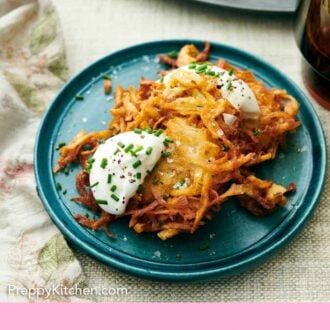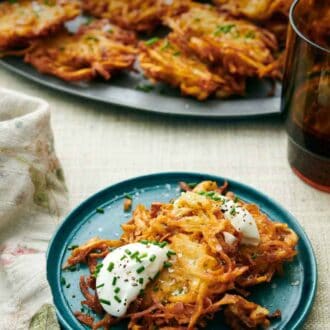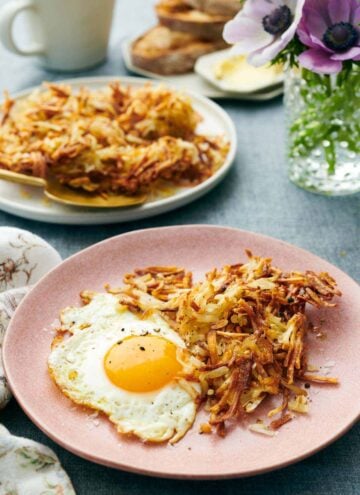Crispy latkes are such a delicious comfort food. These crispy potato cakes are a mainstay during Jewish holidays, but I’ve yet to meet anyone who didn’t love them! After all, they’re the perfect blend of crunchy and tender and can be served with your favorite toppings of choice—what’s not to love?
While they are perfect to make if you’re hosting a Hanukkah or Shabbat dinner, you can make this recipe for perfect latkes anytime. If you’re looking for more potato side dish recipes, then try my homemade potato chips, duchess potatoes, smashed potatoes, or hasselback potatoes next!
Ingredients

Russet potatoes — the same qualities that make Russets ideal for baked potatoes make them the ideal choice for latkes. They are high in starch and turn out very fluffy when cooked. Make sure to peel them first before grating.
Onion — I typically use sweeter yellow onions here, but white onions or shallots will also work.
Large egg — eggs are essential to binding the potato an onion mixture together so they don’t fall apart during frying.
All-purpose flour, salt, & baking powder — flour also acts as a binder for the latkes. Baking powder helps them stay nice and fluffy inside and salt gives them excellent flavor.
Black pepper — because lakes are fairly simple in ingredients, freshly ground pepper is ideal for the best flavor.
Vegetable oil — any neutral-flavored, high smoke point oil will work (avocado oil, canola oil, or peanut oil are also good options). Avoid using extra virgin olive oil, which has a much lower smoke point and can turn bitter if used in high-heat cooking.
What Is The Best Kind Of Potato To Use?
Baking potatoes like Russets or Idaho potatoes are the best option because of their high starch content. Yukon Golds will also work, as they have enough natural potato starch to balance out their waxier qualities.
Avoid red potatoes, as they don’t crisp as well on the outside and create a looser, gummier consistency instead of the light, fluffy interior of baking potatoes.
How To Make Latkes

1. Grate the potatoes and onion using the largest holes of a box grater. (Alternatively, you can use the grating attachment of a food processor.)
2. Place the grated potatoes and onions on a lint-free clean kitchen towel or a large piece of cheesecloth and squeeze out as much liquid as possible.

3. Stir the onion and potato mixture together with the egg in a large bowl. Sprinkle the flour, salt, baking powder, and black pepper evenly over the potato mixture, then stir gently to combine well.
4. Pour ¼-inch of oil into a large, heavy-bottomed skillet Heat it over medium-high heat to 350°F. Working in batches, drop spoonfuls of the latke mixture, between 3 to 4 tablespoons in size, into the hot oil.

5. Press gently with the back of a spoon or spatula to flatten their tops slightly. Cook for about 3 minutes until golden brown.
6. Flip the latkes and cook for an additional 1 to 3 minutes until golden brown. (Adjust the heat as needed to maintain 350°F.) Place the latkes on a plate lined with paper towels or a wire rack set over a small, rimmed sheet tray to drain off any excess oil. Repeat with the remaining potato mixture, adjusting the heat as needed. Serve with sour cream or apple sauce, if desired.

Squeeze Out As Much Moisture As Possible
This is so important for achieving perfectly crispy latkes! Moisture is the enemy of crispness, so you really want to squeeze as much excess liquid out as you can. I recommend placing the mixture in the center of a clean flour sack towel, gathering up the towel and twisting it as tight as possible, and then squeezing the ball of potato and onion mixture to release any remaining liquid.
Can I Use Frozen Hashbrowns Instead Of Fresh Potatoes?
Yes! Thaw 8 cups (680g) of shredded hash browns and stir them with the grated onion—just don’t squeeze out the moisture from the onions. Why? Because frozen hashbrowns are drier than freshly shredded potatoes, so you’ll need a little extra liquid (from the onions) to keep your latke batter together.
Using Flour Versus Matzo Meal
Matzo meal is traditionally used to bind latkes, but I wrote the recipe using all-purpose flour to make it accessible to a wider audience using what is likely in your pantry already. With that said, you can use either!
If you opt to make the switch, just make sure to crush the matzo in a food processor until very fine. Note that you may need to add an extra tablespoon or two since it’s less dense than a scoop of flour.

What to Serve with Potato Latkes
Latkes are traditionally served with a combination of sweet applesauce and tangy sour cream but don’t feel limited.
You can treat them like any other potato pancakes or blini, topping them with smoked salmon or gravlax (or smoked salmon dip!), caviar or salmon roe, or chopped fresh herbs like dill or chives. Alternatively, serve them for breakfast with a runny-yolked poached egg. You could even use latkes in place of English muffins to make eggs Benedict!
Pro Tips For Making This Recipe
- For an extra rich flavor, go traditional and fry your latkes in chicken schmaltz (rendered chicken fat)!
- It’s best to peel and grate the potatoes just before making the latkes, as they will oxidize quickly and turn grey or brown! They’ll still be edible but won’t look as nice.
- You can omit the baking powder if you like. I like adding a small amount to the latke mixture, which helps to create an airy, light interior while the exterior stays crispy. But if you don’t like adding the baking powder, you can skip it.
- When scooping the latkes, try to leave any residual liquid in the bottom of the bowl rather than in the scoop. The excess liquid can cause the hot oil to splatter.
- Use an instant-read thermometer or frying thermometer to help gauge when to start frying. Hitting a temperature of 350ºF is ideal—if it’s much cooler, the latkes won’t crisp and will become soggy with oil. If it’s much hotter, the outsides will burn before the insides have a chance to cook.

Frequently Asked Questions
Yes! While I don’t recommend making the batter ahead of time, as the potatoes will oxidize, you can make the batter, fry it off immediately, and then store the cooked latkes for later. They should keep well in the fridge for up to 3 days or in the freezer for up to 3 months.
Absolutely! Allow the cooked latkes to cool completely before transferring to an airtight container or freezer bag, press out as much air as possible, and freeze for up to 3 months. If you will be stacking them, make sure to separate the layers using parchment paper so they don’t stick together.
You have a few options: either recrisp them in a dry skillet over medium heat, air fry them for 6 minutes at 350ºF, flipping halfway through, or bake in a preheated oven/toaster oven at 325-350ºF for 10-15 minutes.
If you’ve tried this Potato Latkes recipe, then don’t forget to rate it and let me know how you got on in the comments below. I love hearing from you!

Potato Latkes Recipe
Equipment
- Box grater or food processor with grating attachment
- Large, heavy-bottomed skillet, such as cast-iron or stainless steel
Ingredients
- 1½ pounds russet potatoes peeled (690g)
- ½ medium onion peeled (130g)
- 1 large egg lightly beaten
- 3 tablespoons all-purpose flour
- 1 teaspoon salt
- ½ teaspoon baking powder
- ¼ teaspoon ground black pepper
- Vegetable oil
Instructions
- Grate the potatoes and onion on the largest holes of a box grater. (Alternatively, you can use the grating attachment of a food processor.)
- Place the potato and onion mixture on a lint-free kitchen towel or a large piece of cheesecloth and squeeze out as much liquid as possible.
- In a large mixing bowl, stir to combine the potato and onion mixture with the egg.
- Sprinkle the flour, salt, baking powder and pepper evenly over the potato mixture. Stir it gently to combine well.
- Meanwhile, fill a large, heavy-bottomed skillet with ¼-inch of oil. Heat it over medium-high heat to 350°F.
- Working in batches, drop spoonfuls of the latke mixture, between 3 to 4 tablespoons in size, into the hot oil. Press gently with the back of a spoon or spatula to flatten their tops slightly. Cook for about 3 minutes until golden brown. Flip the latkes and cook for an additional 1 to 3 minutes until golden brown. (Adjust the heat as needed to maintain 350°F.)
- Place the latkes on a paper towel lined plate or a wire rack set over a small, rimmed sheet tray. Repeat with the remaining potato mixture, adjusting the heat as needed.
- Serve the latkes with sour cream and applesauce, if desired.
Notes
- For an extra rich flavor, go traditional and fry your latkes in chicken schmaltz (rendered chicken fat)!
- It’s best to peel and grate the potatoes just before making the latkes, as they will oxidize quickly and turn grey or brown! They’ll still be edible but won’t look as nice.
- You can omit the baking powder if you like. I like adding a small amount to the latke mixture, which helps to create an airy, light interior while the exterior stays crispy. But if you don’t like adding the baking powder, you can skip it.
- When scooping the latkes, try to leave any residual liquid in the bottom of the bowl rather than in the scoop. The excess liquid can cause the hot oil to splatter.
- Use an instant-read thermometer or frying thermometer to help gauge when to start frying. Hitting a temperature of 350ºF is ideal—if it’s much cooler, the latkes won’t crisp and will become soggy with oil. If it’s much hotter, the outsides will burn before the insides have a chance to cook.















Leave a Reply